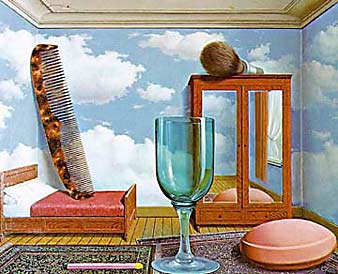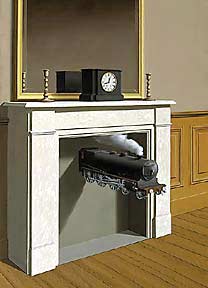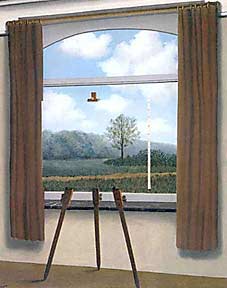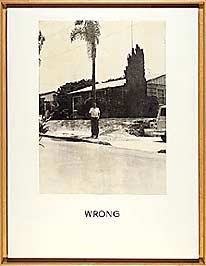Magritte: The Treachery of Postmodernism
The L.A. exhibit took its name from Magritte’s famous 1929 painting of a pipe, an artwork the artist titled The Treachery of Images. LACMA’s expropriation of this title could be interpreted as a sly way of declaring realist painting dead in the here and now, and an appeal for public support of the conceptual art contained in the show. Late in his life, Magritte was quoted as saying, "The present reeks of mediocrity and the atom bomb" - which actually should have been the name of LACMA’s exhibit.
LACMA’s Senior Curator of Modern Art, Stephanie Barron, said that the museum "felt that it was time to not do just another Magritte retrospective." So instead the institution made its guards and staff wear derby hats like the ones that appeared in Magritte’s works (no, we are not kidding), and hired the conceptualist John Baldessari to design the layout and installation of the exhibit. The overall effect, while a bit sensationalist and obviously pandering to an audience more familiar with theme parks than art museums - is not entirely unpleasant. One enters the exhibit through a doorway that replicates the one painted in Magritte’s The Unexpected Answer. The gallery floors are made to look like the skies painted by Magritte - covered as they are with carpets depicting fluffy white clouds on a pastel blue background. Looking up, visitors will see photo reproductions of L.A.’s knotted freeway system plastered on the ceiling. As stated, it’s all a bit gratuitous and theatrical but not altogether disagreeable. A wonderful new career awaits John Baldessari if he would only go into Interior Design and stop torturing the public with his boring and emotionless conceptual artworks.
LACMA’s The Treachery of Images, is more an exercise in justifying postmodern contemporary art than a celebration of the marvelous Magritte. While the exhibit presents sixty-five iconic paintings and drawings by Magritte - many of which are superlative examples of what an inspired and well trained artist can do with oil paint and a good set of brushes - the viewer is expected to accept the juxtaposition of sixty-five other works by thirty-one postmodernist art stars like John Baldessari, Eleanor Antin, Richard Artschwager, and the loathsome Jeff Koons. What is particularly annoying about the LACMA exhibit is its very narrow definition of what constitutes "contemporary art", with artists outside of the anointed gaggle of postmodernist celebrities simply not existing in the museum’s purview.

Of the many stunning paintings on display at LACMA, the jewel in the crown would have to be Magritte’s 1952 masterwork, Les valeurs personnelles (Personal Values.) A surreal vision painted with impressive skill. Gigantic ordinary objects like a comb, shaving brush and wine glass quixotically crowded into a small bedroom, are painted in minute and loving detail. The artist painted the wood grain of the floorboards, the nubs on the Persian carpets, the translucent quality of the comb, and a transparent goblet that reflected all things in the boudoir while allowing the viewer to see through it. It is painting like this that exposes the threadbare quality of works by the other artists in the exhibit.

Watching the hundreds of people examining the artworks in the exhibition was in itself informative. People gathered in awe around the splendid paintings by Magritte, but generally expressed little interest in the postmodernist works, most of which were simply uninspired and boring. The artworks by Magritte imparted a sense of wonder and mystery in the crowds, while the works by the postmoderns left them cold. Why on earth anyone thought to place in this exhibit the feebly drawn doodles by the thoroughly inadequate Raymond Pettibon, is beyond comprehension. Because he incorporates text in his misshapen and cramped drawings is no reason to equate his works to that of Magritte. Likewise, when the king of mediocrity, Jeff Koons, has his large stainless steel Rabbit placed in the gallery - you have to wonder what the curator was thinking. Even the really big names like Ed Ruscha, Jasper Johns, and Roy Lichtenstein seemed awfully tiny in Magritte’s shadow - but then, one unintentional consequence of LACMA’s exhibit is the highlighting of the inadequacies and woeful shortcomings of postmodern contemporary art. When placed against the visionary paintings of René Magritte, the artworks of today’s "moderns" appear laughable.

There are many ways LACMA could have presented the works of Magritte - but they intentionally chose to present him using a postmodern framework. Understanding postmodernism as the great leveling concept opposed to hierarchies; a philosophy that argues all histories ("metapictures") are equal, truth is just a matter of opinion, and standards are just another oppression - it then makes sense that LACMA would present a charlatan like Jeff Koons as being on par with Magritte. The ideas of French postmodernist philosopher, Michel Foucault, seem to play no small part in LACMA’s exhibit, in fact, a museum special lecture titled Foucault’s Magritte and Other Metapictures is slated to be presented at LACMA’s Bing Theater on Feb. 4, 2006.

On the whole, LACMA’s Magritte and Contemporary Art: The Treachery of Images, is unquestionably worth seeing, if only to view the large collection of Magritte’s fabulous paintings. Unfortunately, many erstwhile students and art lovers will be turned away by the steep ticket price for the show, but that misfortune aside, we highly recommend the exhibit - despite our misgivings regarding the postmodern spin.
<< Home